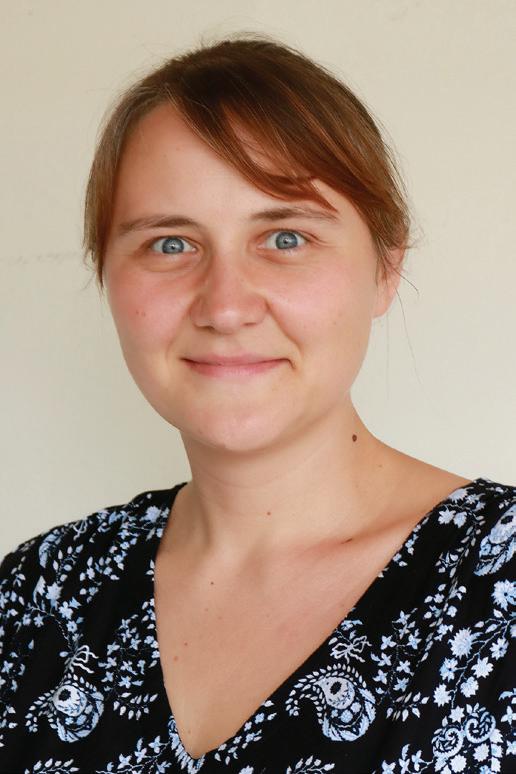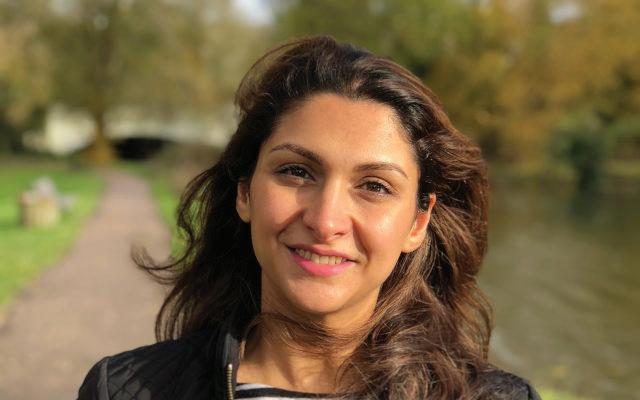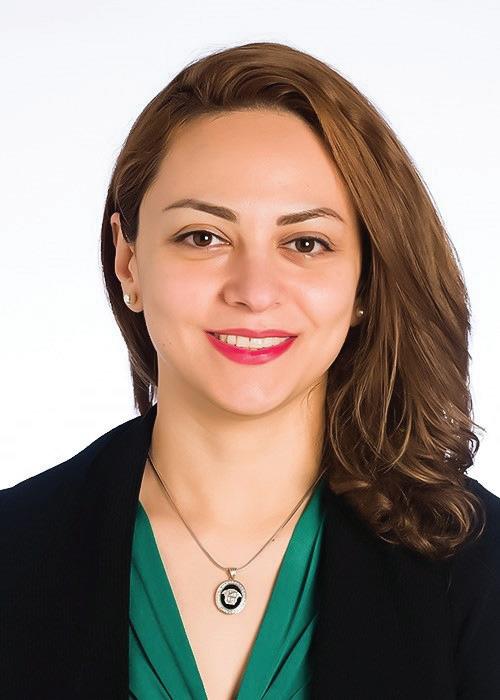
11 minute read
Welcome
Q Welcome
Dr Elena Astroshchenko
Advertisement
Dr Elena Astroshchenko joined the academic staff at CVEN in 2019 as a Senior Lecturer specialising in computational mechanics and numerical methods.
Raised in Russia, Dr Astroshchenko completed her undergraduate and Masters Science degree there, focusing on developing mathematical models for ophthalmology. Then, off to Canada for 6 years and a PhD. It was there, at the University of Waterloo, that Elena’s focus shifted to civil engineering, working as a teaching and research assistant while she completed her own research in computational modelling for fracture mechanics. This research earned her the position of Assistant Professor at the University of Santiago, Chile.
One current project with her colleagues from Santiago is about harvesting energy from piezo-electric plates, but Elena’s main focus will be in acoustics: design optimisation for acoustic devices and structures and health monitoring of structures using sound waves. This work in acoustics takes Elena to the University of Luxembourg each year, where she is an associated member of the international Legato team in computational mechanics. Led by Professor Stephane Bordas, Legato “aims at building intuitive and interactive platforms for computational mechanics problems which allow the users to interact with their models and hence gain insights into unconventional and counter-intuitive phenomena.”
Finite Element Method is the central thesis of computational mechanics. It is employed widely, through software, at commercial levels. Elena Astroshchenko propels her field forward by merging this established numerical method with computer-aided design. Isogeometric Analysis (IGA) is a recent innovation that improves modelling of new designs during development, making modelling easier and quicker. Only developed in the last decade Elena is an expert in an elite but growing field. “It is yet to be licenced commercially, but the many advantages of IGA are making it a popular area for research.” While Elena and her family loved Chile, she hopes to stay still for a little while, here in Sydney, here at CVEN. “I am very impressed with this School and UNSW. It seems big, not only in terms of size, but in its development and possibilities. But the people are very, very friendly, very supportive. I feel like I am home. I love the multi-cultural society here.”
Dr Asal Bidarmaghz

Arriving in Sydney from her position as a Research Associate with the Centre for Smart Infrastructure and Construction at Cambridge University, Dr Asal Bidarmaghz has found her CVEN welcome enthusiastic, warm and practically helpful: “like they were waiting for me”. As a Lecturer in Geotechnical Engineering, Asal brings to us her extensive knowledge and experience in the nascent field of subterranean geo-energy systems, having received her PhD in Civil Engineering (Geothermal Technologies) from the University of Melbourne in 2015.
“There is a problem, a big problem,” she says. World leaders are not fully acknowledging nor acting upon the true impacts of climate change. Moreover, underground climate change is very rarely considered or discussed. Nor is geo-energy utilised as a resource, even though it is ever present, available and the technology to access it has been developed. But Asal Bidarmaghz is a gently hopeful engineer, who believes in the power of hard work and persistence, bolstered by collegiate support and right-minded institutions.
“The challenge with industry is to create business cases for geo-energy system projects. I feel confident, this is do-able. We cannot go backwards.”
Asal’s research, begun during her PhD in Melbourne and continued at Cambridge, reveals the particular climate change challenges created by ever increas
ing urbanisation. Cities create ‘urban heat islands’, where temperatures far exceed those of the surrounding rural areas. This promotes the need for electric cooling, the need for resources.
We need to be asking what effect do our underground structures, such as basements, car parks and activities like transport tunnelling, have on the surrounding environment? Could the heat generated by such activities be extracted and exploited as ‘smart heat’? “In city-scale, there are gigawatts of ground energy freely available to us, but there is a lack of understanding as we continue to burn coal. We need the different sectors working together in urban planning.”
The benefits of geospatial research to city planners, asset owners, local authorities and citizens are many and seemingly obvious: alternative, sustainable and free energy sources, optimal use of subterranean spaces in city planning and positive impacts on general wellbeing of urban inhabitants. Frustratingly, Australian industries and governments are not yet fully convinced; perhaps revealing “a resistance to anything new and expensive”, so this continued research is vital to enacting change in our cities.
Dr Sascha Eisentrager

Dr Sascha Eisentrager arrived in Sydney In June 2019 from Otto von Guericke University in Magdeburg, Germany. He is, however, no stranger to Australia, having completed some of his postgraduate studies in Adelaide. As a CVEN Lecturer and a member of the Centre for Infrastructure and Engineering Safety (CIES), Sascha will be developing his research in Computational Mechanics, especially in high order Finite Elements Methods (FEM).
Dr Eisentrager’s enthusiasm for computational mechanics began early in his career and he has continued to refine his approach. “Computational mechanics (CM) is a broad range of different methods, commonly based in numerical approaches, and used to solve partial differential equations. All physical problems present a certain set of partial differential equations (PDEs) to which we have to apply numerical (approximative) methods. I concentrate on Finite Element Methods in the context of high order shape functions. Commercially, FEMs often utilize linear or quadratic shape functions, but I try to exploit the inherent advantages of high order ones.”
Simultaneously, Eisentrager is developing proposals for the German Research Foundation and the Australian Research Council. These projects will investigate modelling the behaviours of complex acoustic materials like dampening foams. These materials exhibit both open and closed cell structures that make modelling a complex challenge, necessitating high performance computing technology. “We will look at the relationship of these complex materials to the environments in which they are used. In urban areas, uses such as engine encapsulation can reduce noise pollution. Engine heat can be retained to increase start up efficiency, reducing emissions and fuel consumption. These materials could have positive effects on urban well-being.”
Eisentrager would also like to build more understanding between the engineering academy and the engineering industry. “Certain commercial computational methods are based in knowledge from the 1980s and 1990s, while the newer computational research has the potential to greatly increase industrial efficiency. Sometimes industry can be a little conservative, reluctant to invest either time or money to adopt new methods.” He sees the distinction between academic researchers and industry as being neatly articulated by the Pareto Principle. “80% of the work is completed in 20% of the time. To get to that final 20% of the work, a big time and resource investment is needed, but it is here that innovation, academic rigor and excitement lie.”
Dr Ailar Hajimohammadi

Dr Ailar Hajimohammadi joined the academic staff of CIES and the School of Civil and Environmental Engineering as a Senior Lecturer. Originally interested in chemical engineering, Dr Hajimohammadi’s PhD research on sustainable cementitious materials shaped her current focus on innovative construction materials and techniques.
This shift to civil and environmental engineering has allowed her research to become more multi-disciplinary and collaborative. “The most innovative way I can approach my research is to look at the problem from different angles,” she reflects. “Rather than just focusing on what I already know, I want to know how others see the problem, how other disciplines are approaching it. In this way new methods, new solutions appear. Useful, important, but also very interesting for me. Multi-disciplinary university structures allow for increased communication, visibility and opportunities for academics to work in less isolated ways.”
For the last 4 years Ailar has been working with a waste recovery group she led under an ARC Linkage program to uptake landfilling wastes and convert them to valuable products.
She also works with industry and the academy on the many innovative applications of sustainable construction materials. These materials can utilise recycled waste products, can create cheaper, more durable materials as alternatives to traditional concrete. Also, they can be designed to provide insulation, retard fire and dampen noise. In fact, sustainable materials and technologies research has the potential to revolutionise the civil engineering and construction industries. Not only does it represent green innovation in its use of waste materials, but it can transform the affordability of our built environment.
“We may have started with concretes, but sustainable alternatives have evolved into more complicated composites, with more load bearing construction potential. There is tremendous growth in its applications for fire-resistant high-rise buildings and for sound dampening road barriers”, both so important in a city like Sydney where highrise buildings sprout like seedlings and the noise of traffic and construction threatens liveability. “The use of sustainable materials in construction can also extended to other civil applications such as water treatment technologies and soil stabilisation methods, so it is beneficial and interesting to find mutual interest between disciplines.
“Generally, I hope that my research will lead to an increase in the resilience of construction materials while decreasing their negative environmental impact.”
Dr Ali Kashani

In 2019 we welcomed Dr Ali Kashani – a 2018 Churchill Fellow, and expert in the field of sustainable concrete design and technology - specifically waste valorisation and circular economy in concrete design, lightweight concrete, geopolymer concrete, and automated construction 3D printing.
Dr Kashani has extensive experience in research, development, and commercialisation of advanced and sustainable construction materials. His primary research area is ‘Construction Automation’ via development of novel high-performance materials and techniques for construction 3D printing. His other main area of research is sustainable construction materials for the ‘Circular Economy’ including waste valorisation and low-carbon construction materials.
Ali received his BSc and MSc from Iran’s leading technical and engineering university, Amirkabir University of Technology in Tehran. He obtained his PhD in 2015 from The University in Melbourne with research into the rheology and fresh properties of low-carbon geopolymer concrete. As a postdoctoral researcher at The University of Melbourne, his focus widened into development of sustainable lightweight concrete, design of concrete with waste tyre and waste glass, and exploration of the innovative field of construction 3D printing.
He has been the Project Leader in several R&D projects funded (to a total of $645,000) by government entities and construction industry leaders in Australia, to promote research in advanced and sustainable concrete. He continues to look at partnerships with industry. “We are looking forward to working with cement and concrete industries and building standard regulators to prove the viability of using sustainable concrete with recycled materials in different applications”
Automation in construction by 3D printing is another main research interest. And this area is proving equally exciting and fruitful. One of Dr Kashani’s recently papers as a corresponding author about 3D printing was published in the high-impact Elsevier Journal ‘Composites: Part B’ in June 2018. It has attracted 331 citations so far.
It was this area of research which won Ali a prestigious Churchill Fellowship in 2018. The 3D project has the potential, he notes, to assist with more sustainable, faster and safer construction of affordable houses and to provide housing solutions to disadvantaged Australian communities and homeless people. These technologies could also be used to provide rapid accommodation for affected communities after natural disasters such as floods and bushfires.
Professor Xiao-Lin (Joshua) Zhao
In 2019 we were delighted to welcome Professor Xiao-Lin (Joshua) Zhao to the School.

Professor Xiao-Lin (Joshua) Zhao has very recently taken up an appointment as the new Associate Dean (International) for UNSW Engineering.
Professor Zhao’s very impressive academic background began at Shanghai Jiao Tong University where he commenced study at just 16 years of age. Graduating in 1984, with a Bachelor of Mechanical Engineering, he went on to study his Masters degree in the same field. He graduated in 1987 and came to Australia in 1988 to study at the University of Sydney, this time in the field of Civil Engineering, receiving his PhD in 1993. He completed an MBA from the AGSM in 2007, making him an alumnus of UNSW. He also received a Doctor of Engineering (higher doctorate) from the University of Sydney in 2012.
In 2001 Professor Zhao was appointed Chair of Structural Engineering at Monash University.
Zhao has received several prestigious fellowships, such as the von Humboldt Fellowship of Germany, JSPS (Japan Society for Promotion of Science) Invitation Fellowship of Japan, Distinguished Visiting Fellowship Award from the Royal Academy of Engineering, UK, Visiting Professorship Award from Swiss National Science Foundation, National “1000-Talent” Chair Professorship and Chang Jiang Professorship of China.
He has received 25 grants from the Australian Research Council and served on the ERA (Excellence in Research for Australia) Research Evaluation Committee for Engineering and Environmental Sciences Cluster in 2015 and 2018. He has also supervised 40 PhD students to completion.
More recently, Professor Zhao was Head of the Department of Civil Engineering at Monash University for four years after being Deputy Head and Director of Research in the Department for seven years. Professor Zhao has extensive experience working in international environments leading the Department in several major international initiatives such as the Monash-Sichuan University alliance, Monash-IIT-B academy, Monash-Warwick alliance and Monash-Southeast University Alliance.
We look forward to many opportunities for Professor Zhao to share his extensive knowledge and experience with us.










